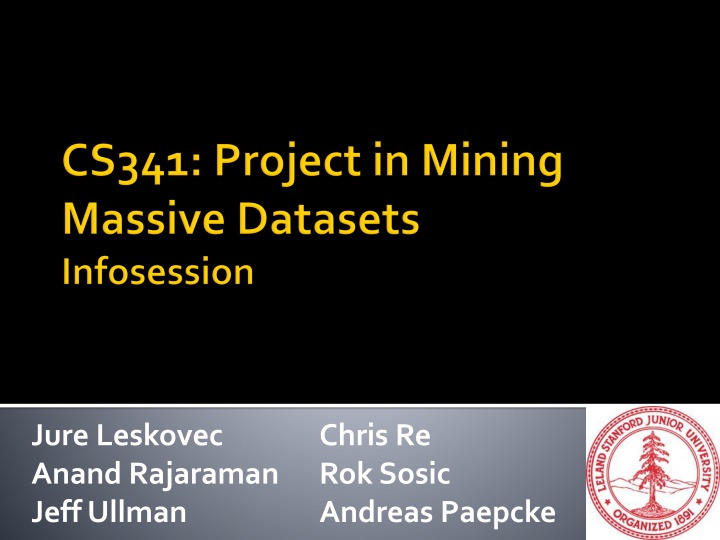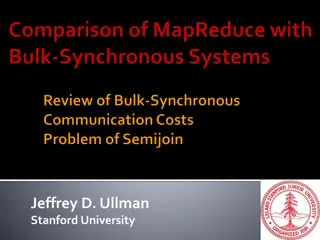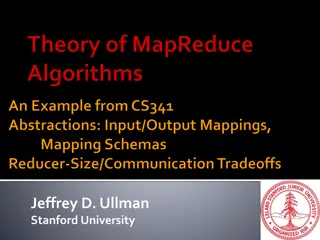
Data Mining Research Project on Real Data at Stanford CS341
Join Stanford CS341 for a data mining research project on real data. Teams of 3 students will work on solving various problems using appropriate data and techniques. Get involved and make a difference in the world of data mining!
Download Presentation

Please find below an Image/Link to download the presentation.
The content on the website is provided AS IS for your information and personal use only. It may not be sold, licensed, or shared on other websites without obtaining consent from the author. If you encounter any issues during the download, it is possible that the publisher has removed the file from their server.
You are allowed to download the files provided on this website for personal or commercial use, subject to the condition that they are used lawfully. All files are the property of their respective owners.
The content on the website is provided AS IS for your information and personal use only. It may not be sold, licensed, or shared on other websites without obtaining consent from the author.
E N D
Presentation Transcript
Jure Leskovec Anand Rajaraman Jeff Ullman Chris Re Rok Sosic Andreas Paepcke
Data mining research project on real data Teams of 3 students (Use Piazza on CS246 to form teams) We have room for 10-15 teams We provide: Data Computers (Amazon EC2, ~~3k$ per team) Mentoring: Each group will have an assigned mentor that they meet on a weekly basis You provide: Project proposals Effort 3/20/2025 Stanford CS341: Project in Mining Massive Datasets 2
Today (3/3): Info session. Friday 3/18: Project proposals due. Friday 3/25: Admission results. 10 to 15 projects will be admitted. Mon 3/28: First class meeting in Herrin 195. Mon 5/2 and Weds 5/4: Midterm presentations. Week of May 30: Final presentations. 3
(1) What is the problem/question your team is solving? Give a brief but precise description or definition of the problem or question Examples: (a) Analyze the data to understand why editors are leaving Wikipedia (b) Build a social recommender engine for movies (c) Design a better MapReduce algorithm for finding clusters in graphs (2) What data will you use? Why is the data you plan to use appropriate? Does it have the right labels/information? It is ok to use your own data (give detailed description)! Examples: (a) Wikipedia edit history where every action of every user is recorded (b) We crawled Yelp and obtained X million reviews from Y million users (c) We will use the Altavista web graph on X million nodes. 3/20/2025 Stanford CS341: Project in Mining Massive Datasets 4
(3) How will you solve the problem? What is your plan of action? Describe and think about your approach! What method, algorithm, technique? How will you scale it up? Be as specific as you can! Examples: (a) We will create edit histories of every article. We will then compare article edit histories and argue that users are leaving since all the easy/obvious articles have already been written (b) Our hypothesis is that friends have similar tastes. We will include a regularization term to a Latent Factor Rec. Sys. which will encourage neighboring users to have similar parameters (c) We will implement a scalable Frequent-itemset-based approach to identify cluster seeds (complete bipartite subgraphs). In the second pass we will then use a random walk based approach to expand around the seed and extract the clusters 3/20/2025 Stanford CS341: Project in Mining Massive Datasets 5
(4) How will you evaluate your method? How will you measure performance or success of your method? What baselines will you use? Examples: (a) Using insights from our analysis we will build a model that will predict how complete is the article (much the article will change in the future). We will evaluate predictive accuracy of the model (b) We will measure RMSE of our system. As a baseline for comparison will use traditional latent-factor recommender (c) We will measure resource usage and execution time of our algorithm and compare it to open source algs. Metis and Graclus (5) What do you expect to submit/accomplish by the end of the quarter? 3/20/2025 Stanford CS341: Project in Mining Massive Datasets 6
Submit to cs341-spr1516-staff@lists.stanford.edu PDF should include Project title Project narrative addressing the 5 questions Information about team members: For each team member:5 line CV/Bio about prior experience, and why you are prepared to take this course No page limit(but we don t promise to read past page 3) Due Friday 3/18 11:59pm Pacific time We will let you know whether you got in by Friday March 25 3/20/2025 Stanford CS341: Project in Mining Massive Datasets 7
Collection of over 70 web and social network datasets: http://snap.stanford.edu/data Social networks: online social networks, edges represent interactions between people Twitter and Memetracker : Memetracker phrases, links and 467 million Tweets Citation networks: nodes represent papers, edges represent citations Collaboration networks: nodes represent scientists, edges represent collaborations (co-authoring a paper) Amazon networks : nodes represent products and edges link commonly co-purchased products
Online media Collection of over 6B news documents and 300M short textual phrases that appear in them Think of this as a complete trace of Internet news media space for the last 6 years! Goal: Detect trending topics and explores the dynamics of online news Based on time, named entities, mutation of information
Exhaustive dataset of scientific papers 123M authors, 123M papers, 757M references Affiliations, keywords, conferences, journals 1.9 billion items, ~100GB Problem Many duplicate entities donald knuth appears 158 times Goal Use textual and network structure features to identify duplicate entries
18 years of Amazon reviews up to March 2013 Product and user information, ratings, review text http://snap.stanford.edu/data/web-Amazon.html
Kaggle (www.kaggle.com) runs competitions. You can get both data + ideas + possibly win. Yahoo (http://webscope.sandbox.yahoo.com/) Interesting datasets, no problem suggestions, but some ideas should be obvious. TREC (http://trec.nist.gov/). Current and historical competitions. May take a week or more to get authorization for data. 3/20/2025 Stanford CS341: Project in Mining Massive Datasets 12
For more detail on a dataset or problem, please contact the appropriate instructor Andreas Paepcke (paepcke@cs.stanford.edu) Anand Rajaraman (datawocky@gmail.com) Chris Re (chrismre@cs.stanford.edu) Rok Sosic (rok@cs.stanford.edu) Jeff Ullman (ullman@gmail.com) Emails for outside contacts are provided at i.stanford.edu/~ullman/cs341slides.html 3/20/2025 Stanford CS341: Project in Mining Massive Datasets 13


